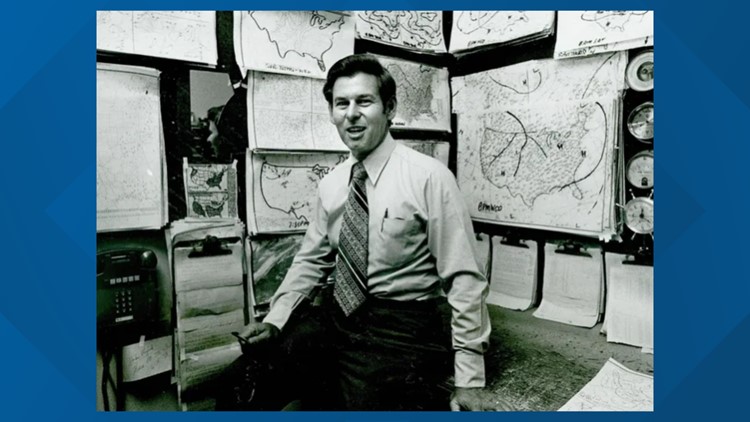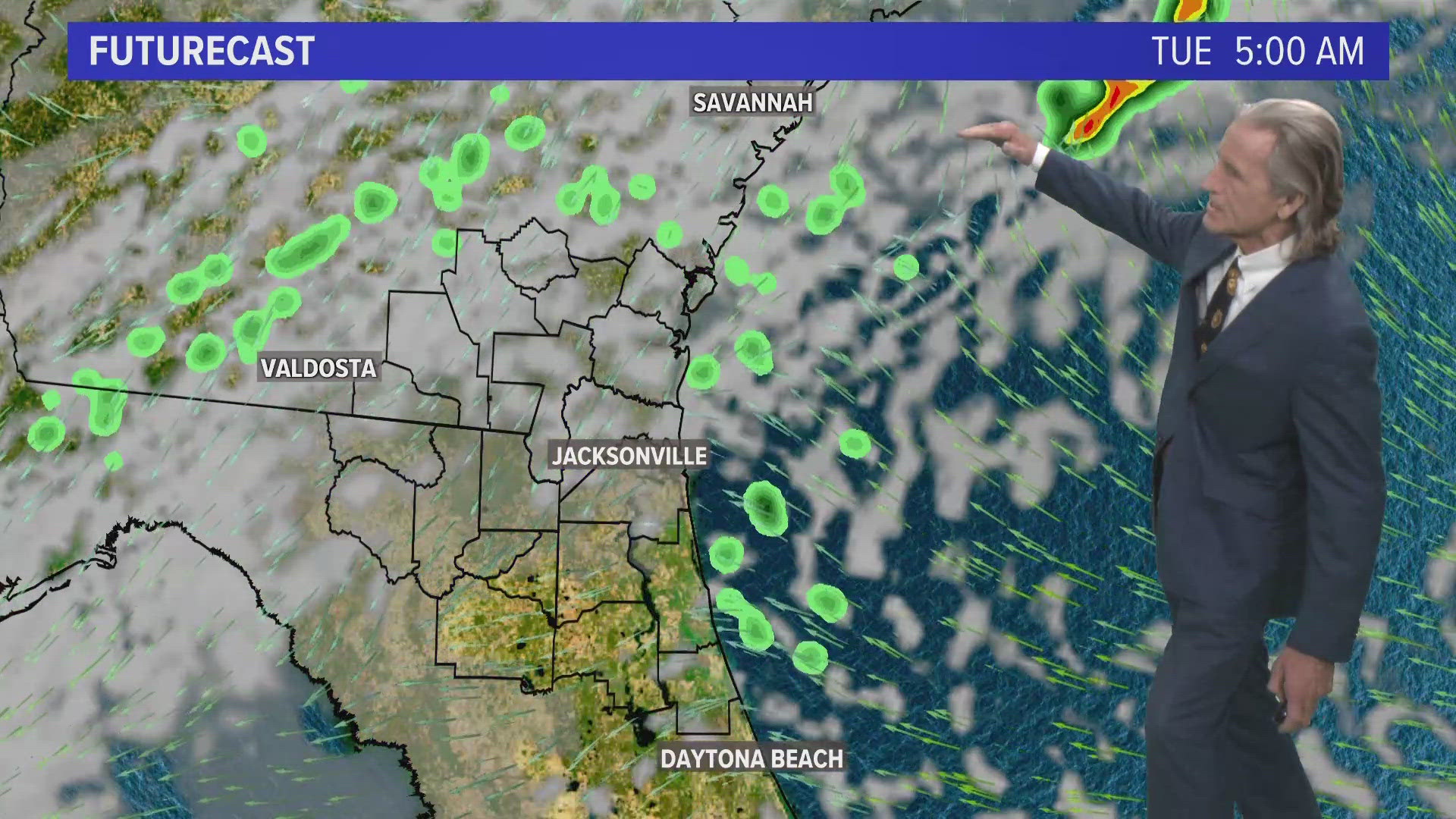JACKSONVILLE, Fla. — George Winterling, a meteorologist whose career at WJXT TV-4 spanned more than half a century of hurricanes and nor'easters, broiling summer days and an occasional cold snap, died Wednesday, the station announced on air that evening. He was 91.
Winterling, who was hired at the station in 1962, was an innovative meteorologist who made his reputation in 1964 by predicting big trouble for Jacksonville from Hurricane Dora, which would be the first hurricane since 1898 to make landfall along the First Coast.
Though he liked to travel throughout the viewing area and report from his TV studio garden, Winterling eschewed flashy tricks and showmanship, instead presenting his reports with calmness, courtliness and a dab or two of folksy humor.
His enthusiasm for his chosen career was always clearly evident, as reflected in his 2018 memoir, "Chasing the Wind: Memories of a Pioneer TV Meteorologist,” in which he wrote of his satisfaction in “sharing the magnificent beauty of weather and its effect on the earth’s landscape.”
Winterling spent his early years near the New Jersey shore, and in his memoir he recalled one afternoon in 1936 when he saw the Hindenburg fly low over the trees. His father later took him and his brother to see the airship’s charred ruins.
George Winterling in Jacksonville
He moved to Florida as a fourth-grader, first to Green Cove Springs, then St. Augustine, then to Jacksonville. He was a Lee High grad and head usher at the St. Johns Theatre on Forsyth Street, one of the city’s grand old theaters in its vibrant downtown.
His book didn’t avoid some tough times in his life. His father took his own life at 39, and his mother drank a lot, as did the man she later married. Winterling wrote how he and his younger brother Richard were sometimes kept awake at night by loud music and fighting, as well as the occasional police visit.
Those experiences, he said, turned him into a lifelong teetotaler.
He also told of the problems he faced as he grew older, including prostate cancer, heart problems and eventually having to give up driving.
After graduating from high school in 1949, he joined the Air Force the next year, hoping to be a pilot, but there was a waiting list for flight school. So he chose meteorology, and after training was sent to Alaska, to the windblown, storm-battered island of Shemya in the Aleutian chain.
Winterling was kept busy making weather forecasts for pilots flying to the Korean War. He also read, from beginning to end, the Bible he brought with him. The more he studied the many intricacies of weather and its effect on people around the globe, the more it appealed to him.
Moving to TV weather forecasting
So after getting out of the service, he studied meteorology at Florida State University, then joined the national weather bureau in his hometown of Jacksonville. TV appealed to him though, and after a few years and a couple of auditions, he was hired at WJXT in 1962, doing three-minute reports at 6 and 11 p.m.
In a 2018 interview, he explained the appeal: “It was closer to the people that were sitting home, watching TV. I thought, with TV, I’m right into their living rooms and I could tell them what’s happening.”
He had a couple of big stories that first year on air: A powerful, damaging nor’easter and then the coldest temperature —12 degrees — to hit Jacksonville since 1899.
When he correctly forecast where Hurricane Dora was going in 1964, his reputation was made.
'Not the heat but the humidity'
Back then, TV meteorology was low-tech, but he was an innovator, coming up with a map that showed the curvature of the earth and building his forecasts from the information given him by a teletype machine that offered weather reports from scattered reporting stations, always trying to figure out what they might mean to Northeast Florida and South Georgia.
Winterling said he remembers how mid-summer humidity made everything feel sticky and a lot hotter. So he came up with "humiture," adding a temperature equivalent moisture factor to the summer readings.
"They always said it was not the heat but the humidity," Winterling said in a 2011 interview. "So I decided to tack some numbers on the temperature when the humidity reached a certain point, and it got so muggy I could report a temperature as what it felt like."
A year later the Weather Service adopted it as the summer counterpart of the wind-chill factor, calling it the heat index.
Winterling was known for getting out the TV, traveling across the viewing area to meet people and capture weather. He also made weather reports from a garden he planted at the station, showing viewers what was being planted and what was ripening.
Many people over the decades quipped, that with a name like Winterling, he was made to report the weather. Perhaps. At one time, someone in promotions at the stations suggested that he drop the “ling” and just be George Winter.
He turned that down quickly: That’s not like him at all.
Moving to semi-retirement
In 2009, at 77, Winterling stepped away from his 47 years of daily duties at WJXT, becoming the station’s meteorologist emeritus and the severe weather expert. After that, he appeared occasionally on the station and wrote weather blogs for its website for a number of years.
He remained a familiar face to generations of TV viewers, and in 2018 his wife, Virginia, laughing, said she knows what happens most times they leave the house: “They still recognize him, and they want to talk to him about the weather. Mostly they ignore me. He’d talk to them for two hours if I wasn’t standing there.”
Winterling understood though: Weather is important to people.
“Throughout my 60 years as a photographer and meteorologist, I enjoyed capturing and sharing the magnificent beauty of weather and its effect on the earth’s landscape,” he wrote in “Chasing the Wind.” “I shudder when I hear weather broadcasters refer to some weather as being ‘nasty’ or ‘bad’... Weather is merely the atmosphere’s response to the balance, or imbalance, in the forces that have made life possible for humans over thousands of years.”



